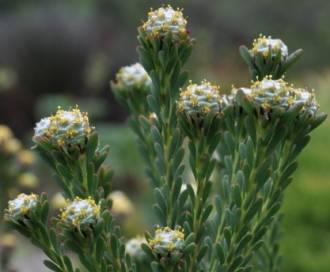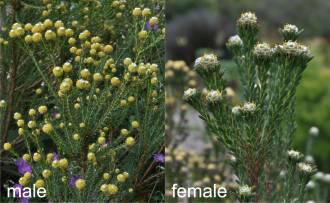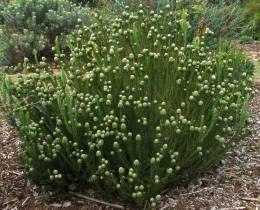Leucadendron linifolium
Leucadendron linifolium (Jacq.) R.Br.
Family: Proteaceae
Common names: line-leaf conebush (Eng.), duineknoppiesbos, knoppiesbos (Afr.)
Introduction
Leucadendron linifolium is a neat, evergreen shrub, water-wise in the winter-rainfall region and ideal for gardens on the sandy flats. It is used as a long-lasting, decorative filler in flower arrangements.

Description
Description
Leucadendron linifolium is a well branched shrub, 1 - 2 m tall with numerous upright, slender branches. It arises from a single stem, but often gives the appearance of being multi-stemmed because it branches low down and sometimes the bases of the lower branches rest on the ground. Like all leucadendrons, it is dioecious, i.e. the male and female flowers are borne on separate plants. The leaves are small, narrow at the base and broadening towards the tips, with a twist at the base. They vary in length, from 7.5 to 27 mm long in male plants and 15 to 35 mm long in female plants. The leaves spread away from the stem and cover the branches, persisting for a few years (i.e. they are present on the current and previous few years' growth). New growth is usually attractively tinged pinkish red.

Leucadendron linifolium flowers during spring (Sept.-Oct.). Male plants have many small, 10-12 mm wide, yellow flowerheads. They are carried singly at the tips of branches and have a yeasty odour. The female flowerheads are globe-shaped, larger that the male flowerheads, 12-14 mm wide, with a few yellow flowers dotted on the silvery green cone-like flowerhead. They are also borne singly at the tips of branches, and have a faint yeasty odour. After pollination the female flowerheads mature and enlarge to form cones up to23 mm in diameter.
The cones are a light, silvery green, and on some plants, as they mature, they become tinged with red. The fruit is a single-seeded, mottled nutlet, 5mm long, 3.5 mm wide and 3 mm thick, egg-shaped with a pointed tip and covered in shaggy hairs. The seeds ripen several months after flowering but the cones containing them are retained on the plant for years. For the female cones to develop normally both male and female plants must be grown so that fertilisation takes place.
.
Conservation Status
Status
Vulnerable. Leucadendron linifolium faces a high risk of extinction in the wild. It has lost 34% of its distribution range and 43% of its habitat over the past 60 years, and this has caused an estimated 30% reduction in population size. Leucadendron linifolium is threatened by urban expansion and coastal housing development, invasive alien plants, agriculture, the drainage of wetlands, the extraction of groundwater and wildflower picking. It appears to flourish in veld that is disturbed, overgrazed or frequently burned.
Distribution and habitat
Distribution description
Leucadendron linifolium occurs in dense, isolated stands on coastal flats from Eersterivier to Strand on the Cape Flats, Bot River to Elim, Bredasdorp and Potberg, and on the Riversdale Flats at Jakkalsfontein. It grows on acidic, neutral or alkaline sands that are often waterlogged during the winter rainy season.
Derivation of name and historical aspects
History
Leucadendron linifolium was first described in 1797 by Jacquin. At the time, botanists were unaware that the male and female of the species were on separate plants, and Jacquin named and described a male plant as Protea linifolia and a female plant as P. fusciflorum. Both names have equal priority of publication, but Williams chose L. linifolium to avoid confusion as L. fusciflorum had also been applied in error to another species by a different author. Other synonyms include: Protea longicaulis Salisbury ex Knight in 1809, and Leucadendron tortum Brown in 1810. It was featured as L. tortum, Twisted Leucadendron, in the Botanical Register in 1824, plate 826, drawn from a male plant cultivated in the Bristol Nursery by Mr. Miller. Meisner in 1826 described it as L. pedunculatum but the herbarium material he used for his description has been lost so its identity cannot be verified.
The generic name Leucadendron is from the Greek leukos meaning white and; dendron, tree. This genus is named after and based on Leucadendron argenteum, the silver tree, from its common name witteboom, meaning white tree, as it was known in the 1690s when the genus was first named. The specific name linifolium means flax-leaved from the Latin linum flax and folium leaf, referring to the shape of the leaves.
The genus Leucadendron belongs in the protea family. It consists of 83 species, most of which occur in the Western and Eastern Cape with a few outliers in KwaZulu-Natal. They are all dioecious shrubs or trees, and are known as conebushes because the female flower heads form woody cones in which the fruits are borne.
Ecology
Ecology
Leucadendron linifolium stores its seeds in woody cones on the plant for a number of years. This is known as serotiny. During a fire, the plant is killed but the seeds survive and are released from the cones after the fire. The seedlings germinate en masse forming fairly dense stands after fires.

Leucadendron linifolium flowerheads are yeast-scented and are pollinated by insects.
Uses
Use
Leucadendron linifolium is popular for its foliage and silver-green cones in the cut-flower trade where it is sometimes still known and sold as 'Tortum'.
Growing Leucadendron linifolium
Grow
Leucadendron linifolium is one of the easiest members of the protea family to grow. It thrives in a wider range of soils than most, from acidic, to neutral or alkaline, and does not mind being waterlogged in winter. It is ideal for gardens on the sandy flats in the Western Cape. It is suitable for strandveld, fynbos and coastal gardens, and will thrive far from home and has been successfully cultivated in many European botanical gardens for hundreds of years.

It is often used as a rootstock for more difficult-to-grow proteas. It needs a sunny position, with well-drained (sandy) soil and free air circulation. It tolerates wind, summer drought and winter waterlogging.
Feed with well-rotted compost, and/or slow-release fertiliser and avoid heavy, clay soils and strong fertilisers. It is not hardy to prolonged freezing temperatures, but should survive outdoors in zone 9 (-7 to -1 °C / 20 to 30 °F). Keep root disturbance to a minimum, the roots of proteaceous plants are susceptible to fungal infection so try not to break them by digging around their base inside their drip-line, rather put down a thick layer of mulch once or twice a year, e.g. in autumn and in spring, and leave them undisturbed. Like many proteaceous shrubs, this species can start to look a bit leggy and unkempt after 8-15 years, when it should be replaced.
Propagate Leucadendron linifolium by seed or cuttings. Harvest cones that are at least 6 months old. Allow them to dry so that the seeds will be released. Sow the seeds in late summer to autumn (March-May). Use a sterile, well-drained soil medium and keep moist. Germination should occur after about 30 days. Treating the seed with Instant Smoke Plus Seed Primer will enhance germination. Transplant the seedlings into individual bags or pots when the first true leaves have developed. Use a well-drained, soil mix suitable for fynbos plants. Grow on for a year before planting out into the garden.
Take semi-hardwood cuttings from the current season's growth in autumn or spring. Remove the leaves from the basal third of the cutting, treat with rooting hormone and place in well-drained rooting medium under intermittent mist with bottom heat of 24 °C. Rooting takes about 6 weeks, harden off for 3 weeks and transplant into individual containers filled with well-drained, soil suitable for fynbos plants. Grow the cuttings in a well-ventilated area.
References
- Plants of southern Africa: an online checklist. http://posa.sanbi.org
- Protea Atlas Project. http://protea.worldonline.co.za
- Leistner, O.A. (ed.). 2000. Seeds plants of southern Africa : families and genera. Strelitzia 10. National Botanical Institute, Pretoria.
- Raimondo, D., Von Staden, L., Victor, J.E., Helme, N.A., Turner, R.C., Kamundi, D.A. & Manyama, P.A. (eds) 2009. Red List of South African plants 2009. Strelitzia 25. South African National Biodiversity Institute, Pretoria.
- Rebelo, Tony. 2001. Proteas, A Field Guide to the Proteas of Southern Africa, 2nd Edition. Fernwood Press, Cape Town.
- Smith, C.A. 1966. Common names of South African plants. Memoirs of the Botanical Survey of South Africa No. 35.
- Mustart, P., Cowling, R. & Albertyn, J. 1997. Southern Overberg, South African Wild Flower Guide 8. Botanical Society of South Africa.
- Bean, A. & Johns, A. 2005. Stellenbosch to Hermanus. South African Wild Flower Guide 5, second revised edition. Botanical Society of South Africa, Cape Town.
- Vogts, Marie. 1982. South Africa's Proteaceae, Know them and grow them. Struik Publishers, Cape Town.
- Williams, I.J.M. 1972. A Revision of the Genus Leucadendron (Proteaceae). Contributions from the Bolus Herbarium No. 3. The Bolus Herbarium, University of Cape Town.
- Eskom Nuclear 1 EIA and EMP, Specialist Study for Environmental Impact Report, Specialist Study: Botany and Dune Ecology, Version 4.0. February 2010. DEIR AppE11 Floral Assessment pp 4.41-4.60.pdf
- The Botanical Register: consisting of coloured figures of exotic plants cultivated in British Gardens; with their history and mode of treatment. Volume X. 1824, plate 826.
Credits
Alice Notten
Kirstenbosch National Botanical Garden
October 2010
Plant Attributes:
Plant Type: Shrub
SA Distribution: Western Cape
Soil type: Sandy
Flowering season: Spring
PH: Acid, Alkaline, Neutral
Flower colour: Yellow
Aspect: Full Sun
Gardening skill: Easy
Special Features:
Horticultural zones











Rate this article
Article well written and informative
Rate this plant
Is this an interesting plant?
Login to add your Comment
Back to topNot registered yet? Click here to register.